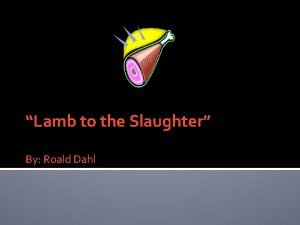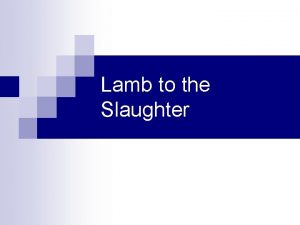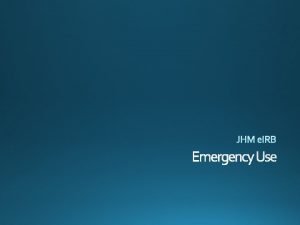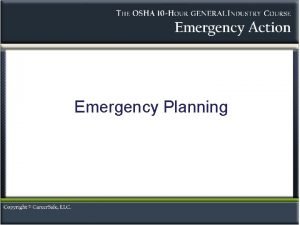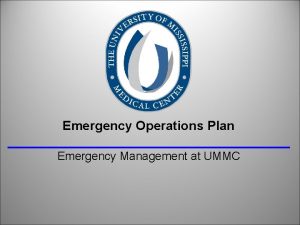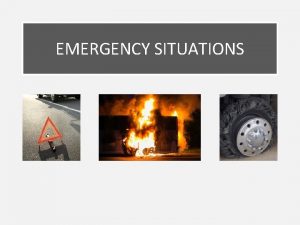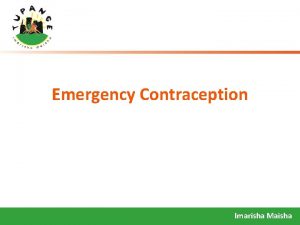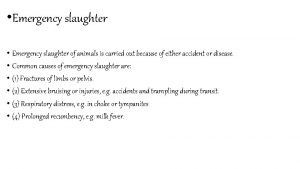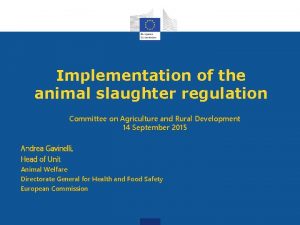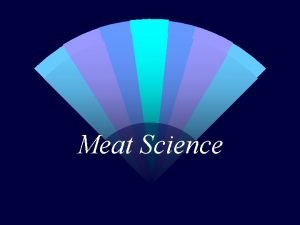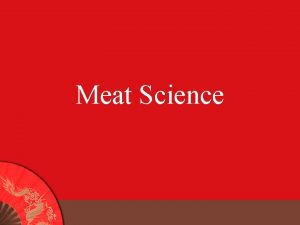Emergency Slaughter Definition The slaughter of an animal
















- Slides: 16

Emergency Slaughter

Definition Ø The slaughter of an animal at the point of death because of injuries or illnesses in order to save the carcass from condemnation in an attempt to market its flesh. Ø Fully justified on economic and humane grounds Ø Careful and critical inspection must be applied? Ø High percentage of food poisoning cases among consumers Ø Bacteriological examination and Chemical investigation are a must

Affections or cases justifying emergency slaughter 1) Fractures of the limbs or pelvis 2) Damage to the pelvis due to slipping (haemorrhagic effusion of adductor muscles) 3) Back injury (heifers during bulling) 4) Struck by lightening or electricity

5) Acute respiratory distress with danger of asphyxia: Tympanitis, consumption of fermented food Esophageal obstruction, turnip root Swallowing of the placenta

6) Prolonged recumbency: Injury to the lumbosacral plexus during parturition Milk fever cases, not responding to calcium treatment Lactation tetany, spring time

7) Penetrating wounds of thorax or abdomen 8) Prolapse of the uterus or dystocia 9) Sever laceration and bruising, particularly head, throat and limbs

Categories of emergency-slaughtered animals 1 - The animal may arrive alive but in a moribund state 2 - The animal may arrive dead/slaughtered and uneviscerated 3 - The animal may arrive dead/slaughtered and eviscerated (dressed carcass form)

1 - The animal may arrive alive but in a moribund state Blood smear for anthrax before unloading Carefully examined Judgment depends on: Bleeding, Setting, Condition of the meat, Color of fat and serous membranes

2 - The animal may arrive dead/slaughtered and un-eviscerated The carcass must not be unloaded unless it is negative for Anthrax Differentiate between vital and cold slaughtering Slaughtering cut edges are not straight, stretched back and very hard to pull them together Slaughtering wound/site infiltrated with blood, not easily washed with water Normal odour and colour of the viscera

Evisceration should not be permitted unless death has been recent (less than one hour) Coldness of the extremities Evidence of tympanitis in the left flank in cattle and sheep Easily pulling out wool in sheep

PM finding of dead and un-eviscerated animals Marked fullness of S/C blood vessels High blood content in lungs, kidneys and liver Dark muscular tissue Objectionable odour when the abdominal cavity is opened Greenish discoloration on the abdominal wall and on kidney fat Liver surface possesses a yellow or greenish discoloration In case of suffocation, the lungs are congested with dark non-aerated blood, right side of the heart is full of blood while the left side is empty

Judgment Carcass of dead animals must be totally condemned Unwholesome, liable to rapid decomposition, fit only for inedible rendering Carcass of vital slaughtered animals Judgment depends on bleeding, setting, meat condition

3 - The animal may arrive slaughtered/dead and eviscerated (dressed carcass form) Great difficulty in judgment especially if unaccompanied by the internal organs…Total condemnation Bacteriological examination for the carcass Carcass examination and Judgment Carcass lymph nodes for enlargement, haemorrhage or tuberculosis Kidneys for the degree of bleeding Degree of congestion (smear from kidney or lymph node to exclude anthrax) and setting of the carcass Pleura and peritoneum Muscular incision for abnormal odour, boiling test Estimation of p. H

General Judgment of Emergency Slaughter Carcass is fit for human consumption Only in cases where the animal has been shortly killed, no evidence of disease and the carcass sets and looks normal Good judgment is supported by bacteriological examination Carcass should be condemned if there any signs of discoloration, contamination, decomposition All animals known or suspected to be diseased or injured must be slaughtered and dressed at either a different place or a different time from other animals

Veterinary certificates of emergencyslaughtered animals All animals submitted to emergency slaughter should be accompanied by a veterinary certificate declare the reason for slaughter and details of any drugs recently used

Information of veterinary certificates Name and address of the owner Marking of the animal Clinical examination/reason for slaughter Declaration by veterinarian stating that the animal is not unfit for human consumption by the reason of disease, condition or treatment
 Lamb
Lamb Animal vs plant cell venn diagram
Animal vs plant cell venn diagram Comparing plant and animal cells venn diagram
Comparing plant and animal cells venn diagram Similarities between animal rights and animal welfare
Similarities between animal rights and animal welfare Hình ảnh bộ gõ cơ thể búng tay
Hình ảnh bộ gõ cơ thể búng tay Slidetodoc
Slidetodoc Bổ thể
Bổ thể Tỉ lệ cơ thể trẻ em
Tỉ lệ cơ thể trẻ em Chó sói
Chó sói Chụp phim tư thế worms-breton
Chụp phim tư thế worms-breton Chúa yêu trần thế
Chúa yêu trần thế Môn thể thao bắt đầu bằng từ chạy
Môn thể thao bắt đầu bằng từ chạy Thế nào là hệ số cao nhất
Thế nào là hệ số cao nhất Các châu lục và đại dương trên thế giới
Các châu lục và đại dương trên thế giới Công của trọng lực
Công của trọng lực Trời xanh đây là của chúng ta thể thơ
Trời xanh đây là của chúng ta thể thơ Cách giải mật thư tọa độ
Cách giải mật thư tọa độ
